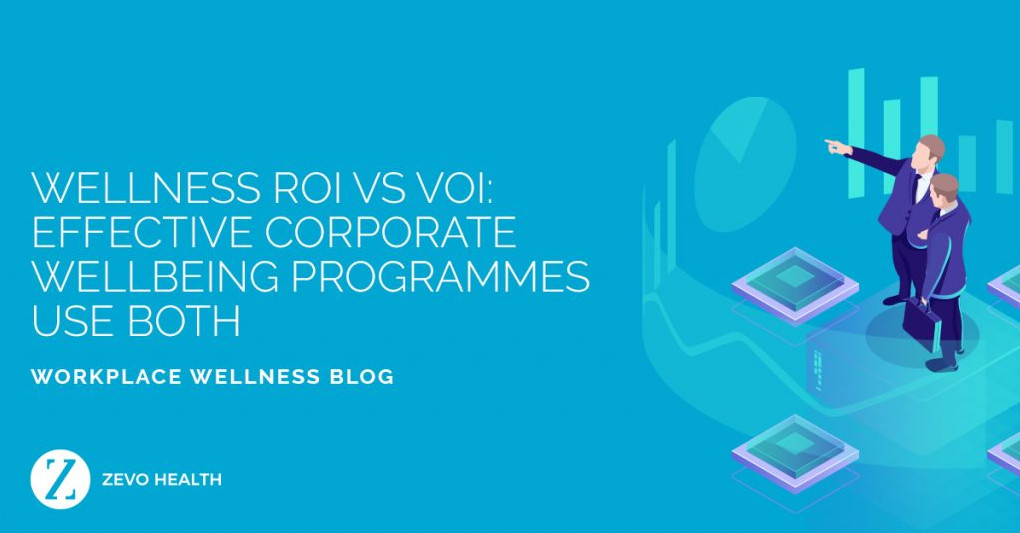
Employee happiness and satisfaction are both critically important for the success of an organization. A happy and healthy workforce means less absenteeism and turnover, and more productivity and creativity. That’s why investing in corporate wellness programmes is becoming increasingly popular among businesses of all sizes.
In this article, we’re going to compare the ROI (Return on Investment) with the VOI (Value on Investment). But, before we get started, it’s important to discuss the importance of corporate wellness programmes and why companies should consider investing in them.
Why are corporate wellness programmes important?
If you have even just a passing interest in HR matters or employee engagement, you may have noticed that phrases such as ‘workplace wellness’ or ‘workplace wellbeing’ are quickly becoming the buzz words of the day. In-fact it seems there are more and more companies are jumping into the ‘wellness’ space and seeking out complete corporate wellness across their organisations.
It certainly seems intuitive that happy employees are more likely to complete higher-quality work, build stronger relationships with clients and colleagues. Richard Branson is quoted as saying ‘If you take care of your employees, they will take care of the clients’. In the real world, however, your organisation must decide where to direct finite financial resources, doing this responsibly requires a sound basis on which to make decisions…and that’s where the return on investment (ROI) comes in. The traditional and transactional view – if we spend X, what tangible benefit will we get in return?
Would I catch your attention if I said a company employing one hundred people could add 170 days to their capacity just by implementing an evidence-based corporate wellness programme? Well, Baicker, Cutler & Song, 2010 carried out a review of over 20 individual studies, each lasting an average of 2 years and found that a tailored wellbeing intervention programme reduced absenteeism by an average of 1.7 days per employee per annum.
Just like every other area of the business, to ensure accountability, it is important to measure the right things. Baseline data is key, covering areas such as absenteeism levels, employee health costs and employee retention and productivity combined with a clear strategy to monitor over time.
Employee Health Care
According to an HSE report “The cost of workplace injury in 2013/14 was £4.9 billion and equivalent to £7500 per non-fatal injury”. Companies are now taking a proactive approach in order to reduce the likelihood of workplace injuries.
Health screenings in the workplace are becoming more and more popular and critical as it helps to identify health risks among employees and therefore reduce the likelihood of workplace injury occurring.
The most obvious benefit of a corporate wellness programme is improved employee health. When your employees are healthy, they are less likely to take time off work due to illness.
This leads to increased productivity and reduced absenteeism. By providing your employees with tools and resources to improve their health, such as gym memberships, healthy food options, and mental health support, you are investing in their well-being and your business’ success.
Reducing Absenteeism
Decreasing your absenteeism levels among your employees is crucial to improving your organisation’s bottom line. Corporate wellness programmes led to a 25% reduction in absenteeism.
People are out of the office for many reasons, such as burnout, the flu and workplace accidents. Implementing a wellness programme can help with reducing all these factors and in return improve the bottom-line of your company.
Measuring the effect of a wellness programme has on absenteeism levels is very simply done. Compare absenteeism numbers for employees to the following year and calculate the rate of change.
Employee Retention
For companies, retaining great talent is becoming more and more difficult as employee levels in Ireland are increasing every year. Implementing a wellness programme is now a strategic move for companies in order to help them retain their current employees. According to a report carried out by WebFX, 45% of employees say wellness programmes help them stay with a company.
Organisations that offer corporate wellness programmes are more attractive to potential hires. Employees view these benefits as a valuable asset, and they are more likely to stay with a company that invests in their well-being. This leads to lower turnover rates and saves your business time and money spent on recruitment and training.
 Value on Investment
Value on Investment
For many companies, wellness programmes are implemented with the hopes of reducing employee health costs and decreasing the level of absenteeism, but what should also be considered is improving employee job satisfaction and productivity.
To simplify it, the value of the investment is a way of finding out how your workplace wellness programme is affecting the more qualitative measures of our organisations.
Measuring VOI can often be difficult when it comes to corporate wellbeing programmes. From our studies and the many wellness programmes we have implemented, a programme that is customised to suit specific employee goals and needs is much easier to measure the VOI.
Implementing a tailored wellness programme in your organisation results in a more effective approach and helps determine the measurement of VOI.
Depending on the tailored programme that is created for your company, there are many factors which can determine the VOI of the wellness programme. The following are some of the most popular VOI measurement factors.
Improving Company Culture
When wellness is adapted within a culture and is fed down from the top management, it has a roll-on effect and it helps with promoting the well-being of all employees within the company.
When management has a strong sense of wellness, this reflects on the culture of the company. When a company has a culture of wellness, is can contribute to how productive employees are and how successful the overall company is.
Measuring the culture of wellness within a company can be done in many ways such as, promoting walking clubs and determining how many employees take part. Employees drinking more water or availing of healthy snacks that are provided is also some factors that can be measured. All these small changes can help with improving the company’s culture of wellness.
Staff members who are engaged with their colleagues are shown to be more willing to go the extra mile for their employer. Enhanced communication, teamwork and collaboration between staff leads to a culture of inclusion, respect and support where staff members feel well-supported to perform, achieve and inspire.
 Increased Productivity Among Workforce
Increased Productivity Among Workforce
The level of productivity within a company is crucial to the success of any business. Poor employee productivity refers to a situation where an employee is physically present at work, but “not there” mentally.
Low productive levels within a company can be caused by many factors such as stress, lack of sleep and mental health problems. According to a survey conducted by the Employee Benefit News, 31% of respondents rated mental illness as the number one reason for loss of productivity. This is why implementing a mental health strategy into your wellness programme is critical for increased productivity levels among a workforce.
It is very clear that happy and healthy employees lead to a more productive workforce. A survey carried out by The International Foundation of Employee Benefit Plans found that “among employers offering and measuring wellness efforts, more than half saw a decrease in absenteeism.”
Obviously, healthy employees are more productive and motivated, leading to higher levels of job satisfaction, improved performance and increased retention.
If your employees are being looked after in work, they are in better moods, they miss less work and are more aware of the importance of looking after their health. All these factors and more contribute to a more productive workforce as a result of implementing a tailored strategic wellness programme into your organisation.
Customer Service
When it comes to VOI on your corporate wellness programme, another factor to look at and measure is how engaged your workforce is with your customers. If employees are happy and healthy as a result of implementing a well thought out, tailored strategic wellness programme, this will result in better customer service as your employees have more energy and are not distracted by health issues.
If employees are stressed within or outside the workplace, this will reflect on the service they provide to your customers. Increased customer service from your employees is another VOI as a result of a wellness programme.
Wellness programmes can help reduce the number of sick days that employees take. This means fewer instances of short-staffing, which can often lead to poor customer service.
More importantly, corporate wellness programmes also help reduce stress, which improves mental health and improves the chances of employees being more calm and patient when dealing with customers.
 Evaluating Your Wellness Programme
Evaluating Your Wellness Programme
Evaluating the effectiveness of a workplace wellness programme is very important and crucial as it helps to look for areas of improvement for the following year. There are certain areas that can be difficult to measure as there can be factors outside the workplace that can help improve the lives of employees.
We are very aware of the importance of measuring the effectiveness of corporate wellness programmes and having a positive impact on a workforce within a company. Before we implement a programme, we conduct a survey within the organisation, so we have a benchmark which allows us to compare results and the effectiveness of the programme over time.
We continuously measure the programme and implement changes where needed. If there are certain areas in your business that you are struggling in, for example, your absenteeism levels are extremely high, these will be measured continuously over time and certain factors will be implemented in order to achieve the required objectives for your certain struggling areas.
Zevo Health are a corporate wellness company that understand employers want to see the value of their money when they invest in a wellness programme, but it is also important to take on board that corporate health and wellness can also add value to the lives inside and outside of the workplace for your employees. This value comes in the form of decreased absenteeism, better retention and improved productivity levels. Our workplace wellness platform aims to improve the quality of life for everyone in the workplace and ensure everyone is happy and healthy in their place of work.

 Value on Investment
Value on Investment  Increased Productivity Among Workforce
Increased Productivity Among Workforce  Evaluating Your Wellness Programme
Evaluating Your Wellness Programme 
